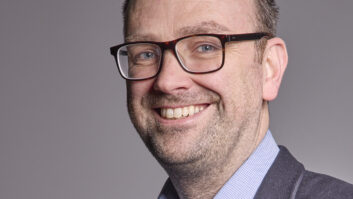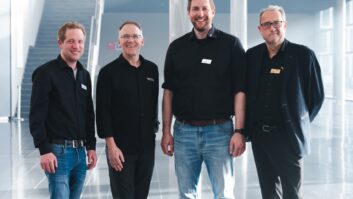During times when there’s not much real news to report, the newspapers – in the UK at least – will often turn to the subject of boardroom salaries, and use these as an opportunity to express much self-righteous indignation about ‘fat cats’, inequality and the ability of management to say one thing (“we can’t afford pay rises this year”) and do another (give themselves large pay rises).
In July, for example, the UK’s Daily Telegraph newspaper reported that, during a period when the stock market value of their companies fell by an average of more than 20%, directors of those companies paid themselves around 15% more. It can seem that directors – and their perks – are immune from the financial realities around them.
In theory, therefore, at a time when many companies are reining in spending as the global credit situation worsens, there is one part of the audiovisual world that is unlikely to have experienced a downturn. That part, you would think, is boardroom installations. Spending in other parts of the business may be on a tight rein, but are different rules being applied when it comes to state-of-the-art audiovisual equipment for directors? How resilient is the boardroom during an economic downturn?
The answer, unsurprisingly, isn’t a straightforward one. There’s still plenty of business out there, it seems – but it’s definitely not a “money no object” business.
“No, boardrooms aren’t recession- proof,” says Nigel Tallick, marketing manager at Pixel Projects, a trade-only AV installer, “and every tender gets more and more competitive. It’s not a market that’s in decline, though – and that’s perhaps a function of the increasing number of companies that have videoconferencing at the heart of their boardroom installa- tion. This allows them to save money on travel costs as well as helping to minimise their carbon footprint.”
“We have a flow of boardroom projects and enquiries,” adds John Belcher, senior technical sales manager at AV integrator Saville Audio Visual, “but they seem to be much more competitive on price than they used to be.”
Tallick’s point about the rising popularity of videoconferencing for the boardroom is echoed by Dave Chester of Custom Controls, which designs and installs bespoke audiovisual, videoconferencing, lighting and automation systems for boardrooms.
“The boardroom market is buoyant,” he says. “We have a number of exciting projects on our books at the moment, and a number in the pipeline for the rest of the year. I couldn’t say if the market was growing or our reputation is driving the amount of work we are getting, but we are certainly seeing more work coming through. If anything, boardrooms are probably more relevant in a recession – videoconferencing systems cut down on the amount of travel required, saving time and expensive fuel use.”
Boardroom bids are becoming more competitive – and it seems as if directors are trying to save their businesses money by economising on travel. It certainly doesn’t appear that they are writing blank cheques. “It’s certainly not true that money is no object,” says Andy Brymer, chairman of audiovisual systems integrator Reflex. “While directors want the right tools for the job, and will pay for them, they are far from naive and will purchase professionally. In fact, we’re increasingly seeing consultants involved in boardroom installation projects – that’s a sure sign that directors are looking for professional advice to ensure they’re getting the best value for money. I also believe that, in the increasingly tough market conditions in which we are working, directors are quite sensitive to the impression they portray to their staff: ‘functional’ is becoming far more important than ‘flashy’.”
“A definite trend,” he continues, “is that we’re seeing a move away from prestige for prestige’s sake. More important for our customers are performance, ease of use and flexibility.”
The right look
But while prestige for prestige’s sake may no longer be what our American friends call a ‘careabout’, it seems to be no less true than it ever was that a boardroom has to look good. “There still ideally has to be that wow factor – the impact the entire room makes – and the room must reflect the way the business sees itself,” says George Rutson, a director at Gresham Wood Technical Furniture and Design. But if you ask installers and integrators about the challenges involved with boardrooms, a common refrain is the difficulty of providing a large amount of advanced electronic equipment – and then making the room look as if there’s no equipment in it at all. “Making an environment that reflects the company’s ethos and operation is a challenge,” remarks Rutson.
“Selling the technology is easy,” adds Chester, “or at least, it’s easier than getting the overall feel of the room just right.” “That’s the real art,” agrees Brymer. “Providing all the functionality the customer wants – but ensuring that the aesthetics of the room are uncompromised. Making it all as easy to use as possible is a big challenge too.”
Another issue arises in the area of audio. “Especially when we’re talking about videoconferencing,” says Tallick, “the client has to fully understand the issues around voice reinforcement, for example.” Belcher nods in agreement. “High-quality pick-up for audio– and videoconferencing does seem to be a challenge,” he notes. “Customers want superb audio quality, but they don’t want to see any microphones.”
And then there’s the plethora of options. “There is a vast array of manufacturers and brands to choose from,” says Paul Smith, sales and marketing director at AV systems integrator and services provider AV Machines. “Getting the correct one can be tough, especially within budget.”
Mixed-use venue
A phenomenon that is beginning to appear, however, is that the boardroom is no longer just the preserve of the directors for their weekly or monthly meetings – or for hosting important clients. Possibly as a byproduct of the fact that videoconferencing facilities are becoming an integral part of the boardroom, the rooms themselves are becoming multipurpose.
“Boardrooms are definitely multifunctional,” continues Smith. “One can have a small video meeting with a couple of participants through to full conferences with participants over audio, video and even via the web through streaming. This can have only positive effects on the AV market. The boardroom is becoming a collaborative communications centre.”
Of course, ‘collaborative communications’ is one of the new names for videoconferencing… “They’re becoming more of a ‘nerve centre’,” notes Rutson, “where meetings are generated online or via IP between worldwide offices, clients or purely interconnecting between offices.”
“Without doubt, the move is towards multifunctional and away from the big table for board meetings,” Brymer says. “The AV implications are that we are having to devise quite complicated solutions that are still aesthetically pleasing. It is also true to say that we have been involved in a number of new-build and office refurbishment projects for high-profile clients that do not have a boardroom at all.”
Belcher agrees. “Today, boardrooms seem to be used for many management meetings, too. For us, this has to be a good thing because the audiovisual equipment is being used – and people want more AV meeting rooms when they can’t get into the boardroom!”
Tallick has a specific example of how this multifunctionality can turn out in practice. “We’re currently involved in the design of a large AV system for a prestigious company in London,” he says. “The requirement is for the large room to have everything under the control of an AMX control system, but also to have the capability, at the touch of a button, of dividing into two separate rooms – via a motorised, soundproof dividing wall – where one room can act as a slave to the other. There are multiple functions on all the tables, including local 17in monitors in each desk to view the VC, which uses one 84in plasma at one end of the room and an HD projector at the other end. These display devices can show DVDs and live TV as well as computer presentations. All tables have the ability to connect laptops via VGA connection, as well as network connections for laptop presentations, including audio.”
Flat market
If one change that systems integrators are seeing is in boardrooms no longer being single-use facilities, another has been what’s being used to deliver images. As in many other parts of the audiovisual market, flatscreen technologies are becoming increasingly popular. Once, if a company wanted an image large enough for everyone to see, the only choice was a projector. However, these are now being displaced by plasma and LCD. “I can’t recall us installing a front-projection solution in a boardroom in the past 12 months,” says Brymer, “although rear projection is still the preferred approach in some instances.”
“The advantages of a flat screen can be huge,” says Chester. “There’s no need to close the blinds, presenters don’t cast shadows on the image, you don’t need lifts and motorised screens – and, nowadays, you get a great image too. Of course, beyond a certain room size, you still need a projector.”
Tallick agrees. “In smaller boardrooms,” he says, “there’s definitely a trend towards flat-screen technologies, but in larger boardrooms, projectors are still used. The quality of projectors is now even better with the advent of HD and 3-chip DLP technology. There are also a lot more ‘funky’ devices to hide the projectors in the ceilings, for example, mirror rigs and rotating ceiling panels.”
One manufacturer of those ‘funky’ devices for positioning equipment such as a flat-screens or projectors is Chief Manufacturing, where Robert de Jong is product marketing manager. “With the relatively high investment often made in a boardroom,” he says, “it needs to be fine-tuned to perfection. That will often mean hiding equipment out of sight in order to preserve the design of the room itself.” “Projection still has its place,” concludes Belcher, “but it is often the case that the customer’s perception is that plasma or LCD have a more high-tech image.”
Open for business
The answer to the question of whether the boardroom market is recession-proof for installers and integrators seems to be an equivocal one. There is undoubtedly business out there – both new builds and refurbishments – but the changes taking place indicate that, if it ever was an ‘open cheque’ market, it is no longer so.
“Boardrooms aren’t necessarily more profitable for us than any other part of our business,” notes Chester. “However, they do provide a great opportunity for us to differentiate ourselves and add value by being able to propose a complete, bespoke solution that, in effect, allows us to take a blank room and provide the client with a bespoke boardroom. To make that happen, though, you have to work with trade partners you can really trust.”
It appears to be the case that companies are having to stretch their money further – make it work harder for them – and they are taking the opportunity afforded by videoconferencing to both reduce their travel costs and to make better use of what would otherwise be an underutilised asset. On the other hand, some things aren’t changing: aesthetics and ease of use, for example, continue to be key elements of a successful boardroom installation. How the market develops, if the current economic climate continues, will be interesting to observe, but it seems likely that value for money, price/performance and return on investment will continue to characterise winning proposals.







